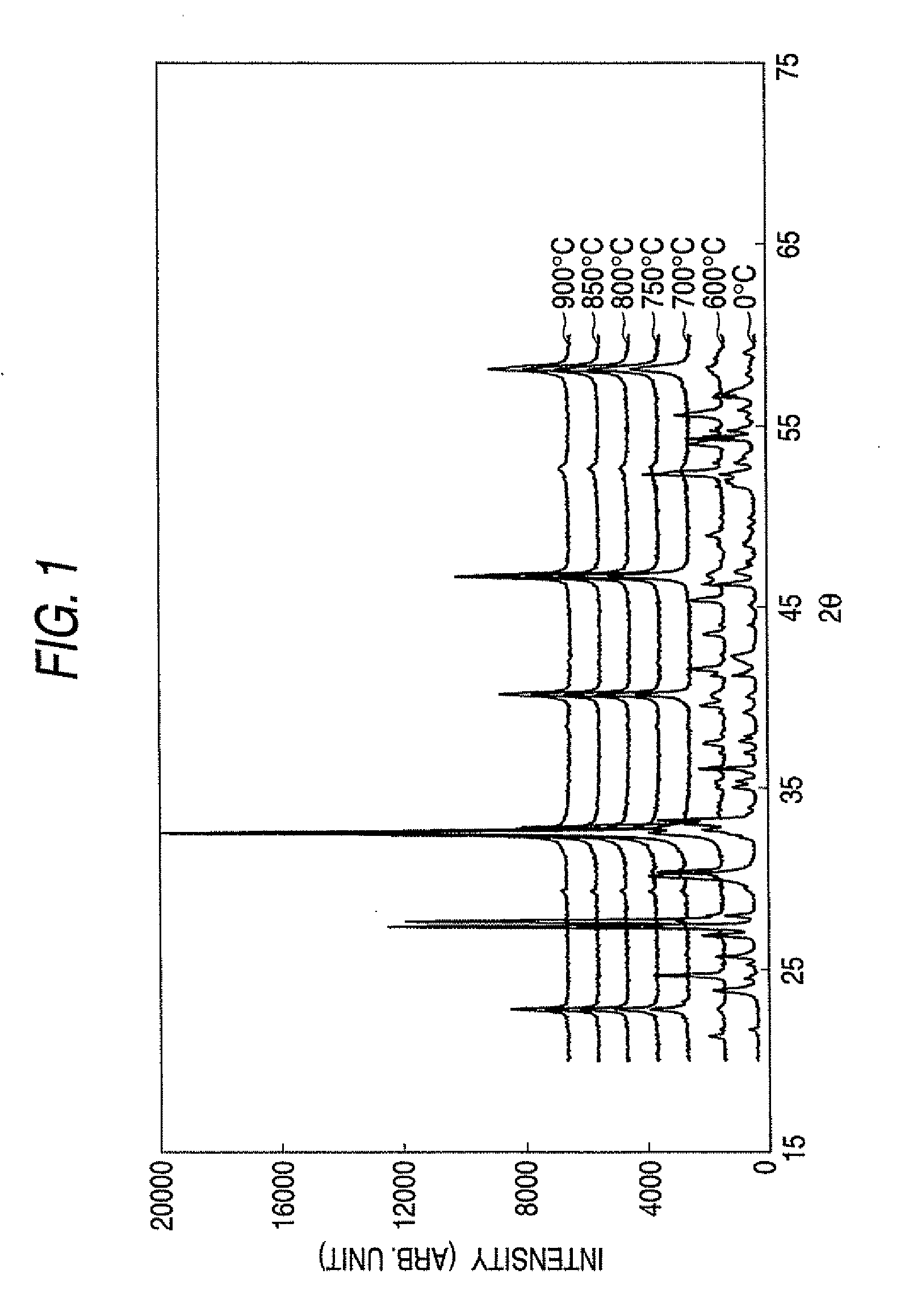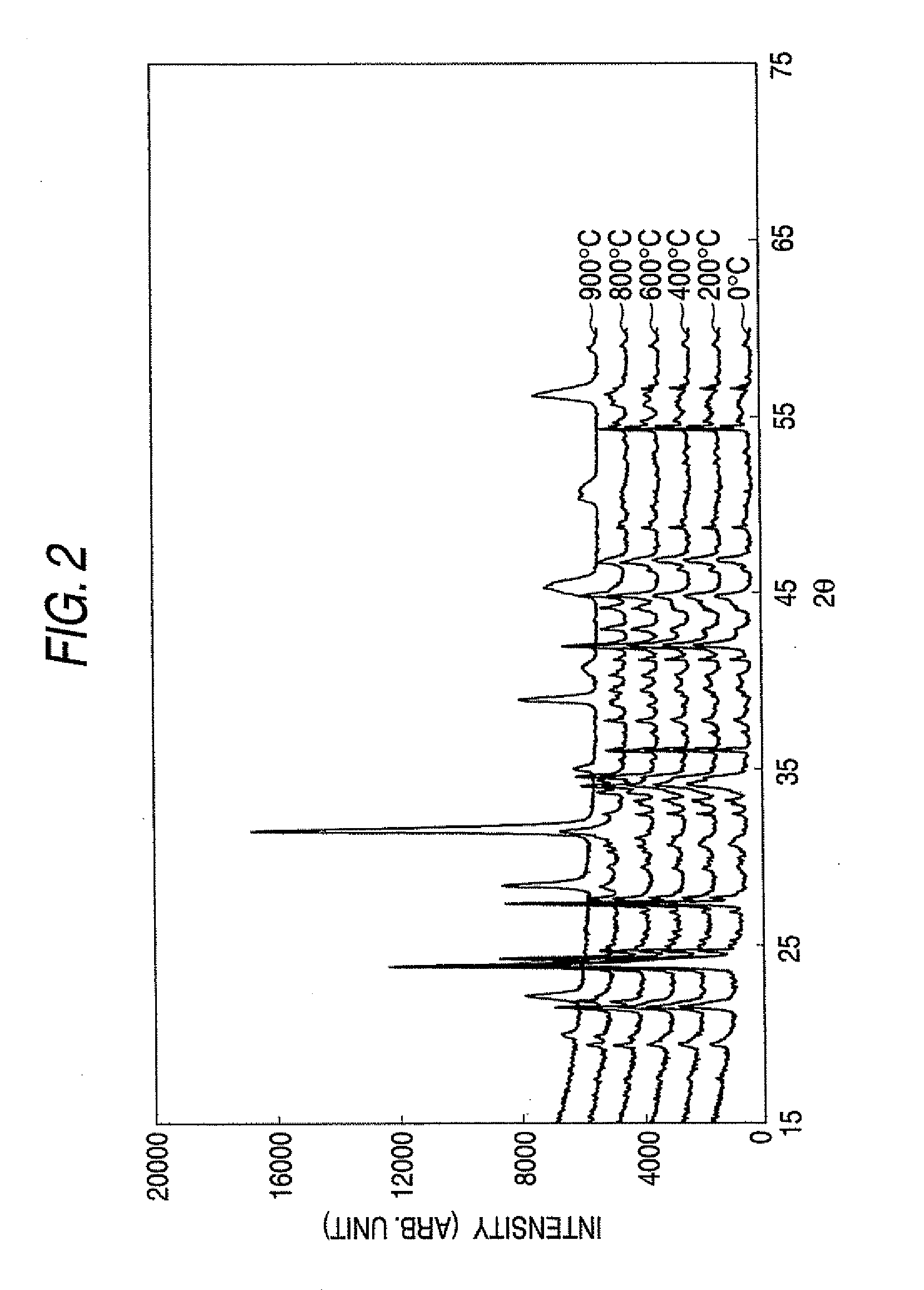Semiconductor Porcelain Composition and Method of Producing the Same
a technology of semiconductor porcelain and composition, applied in the field of semiconductor porcelain, can solve the problems of reducing the temperature coefficient of resistivity (jump characteristic), inability to achieve desired characteristics, and inability to form complete solid solutions, so as to facilitate the control of resistivity, prevent compositional shift, and inhibit abnormal growth of crystal grains
- Summary
- Abstract
- Description
- Claims
- Application Information
AI Technical Summary
Benefits of technology
Problems solved by technology
Method used
Image
Examples
example 1
[0057]BaCO3 and TiO2 as the main raw materials, and a raw material powder of La2O3 as the semiconductive dopant were prepared and blended to satisfy (Ba0.994La0.006)TiO3. Furthermore, 0.3 mol % of SiO2 and 1.2 mol % of CaCO3 were added as sintering assisting agents, and they were mixed in ethanol. The mixed raw material powder thus obtained was calcined at 100° C. for 4 hours to prepare a calcined powder of (BaLa)TiO3.
[0058]Material powders of NaCO3, Bi2O3 and TiO2 were prepared and blended to satisfy (Bi0.5Na0.5)TiO3. Furthermore, 0.08 mol % of SiO2 and 0.27 mol % of CaO were added as sintering assisting agents, and the resultant matters were mixed in the atmosphere (dry type) or in ethanol (wet type). The mixed raw material powder thus obtained was calcined at 600° C. through 900° C. for 4 hours in the atmosphere to prepare a calcined powder of (BiNa)TiO3. FIG. 1 shows X-ray diffraction patterns of the obtained calcined powder of (Bi0.5Na0.5)TiO3 at respective calcination temperat...
example 2
[0064]BaCO3 and TiO2 as main raw materials, and a raw material powder of La2O3 as semiconductive dopant were prepared and blended to satisfy (Ba0.994La0.006)TiO3. Furthermore, 0.3 mol % of SiO2 and 1.2 mol % of CaCO3 were added as sintering assisting agents, and they were mixed in ethanol. The mixed raw material powder thus obtained was calcined at 1000° C. for 4 hours to prepare a calcined powder of (BaLa)TiO3.
[0065]Raw material powders of NaCO3, Bi2O3 and TiO2 were prepared and blended to satisfy (Bi0.5Na0.5)TiO3. Then, 0.08 mol % of SiO2 and 0.27 mol % of CaSO3 were added as sintering assisting agents, and the resultant matters were mixed in the atmosphere or in ethanol. The mixed raw material powder thus obtained was calcined at 650° C. through 1000° C. for 4 hours to prepare a calcined powder of (BaNa)TiO3.
[0066]The calcined powder of (BaLa)TiO3 and the calcined powder of (BaNa)TiO3 were blended to satisfy [(Bi0.5Na0.5)0.1(Ba0.994La0.006)0.9]TiO3, and then they were mixed, crus...
example 3
[0073]BaCO3 and TiO2 as main raw materials, and a raw material powder of La2O3 as a semiconductive dopant were prepared and blended to satisfy (Ba0.994La0.006)TiO3, and they were mixed in ethanol. The mixed raw material powder thus obtained was calcined at 1000° C. for 4 hours to prepare a calcined powder of (BiLa)TiO3.
[0074]Raw material powders of NaCO3, Bi2O3 and TiO2 were prepared and blended to satisfy (Bi0.5Na0.5)TiO3, and they were mixed in ethanol. The mixed raw material powder thus obtained was calcined at 600° C. for 4 hours to prepare a calcined powder of (BiNa)TiO3.
[0075]The calcined powder of (BiLa)TiO3 and the calcined powder of (BiNa)TiO3 were blended to satisfy [(Bi0.5Na0.5)0.1(Ba0.994La0.006)0.9]TiO3, and they were mixed, crushed, and then dried by a pot mill using ethanol as a medium until a mixed calcined powder became to have a size of 0.9 μm. The crushed powder of the mixed calcined powder was added and mixed with PVA and then granulated by the granulating appara...
PUM
| Property | Measurement | Unit |
|---|---|---|
| temperature | aaaaa | aaaaa |
| temperature | aaaaa | aaaaa |
| temperature | aaaaa | aaaaa |
Abstract
Description
Claims
Application Information
 Login to View More
Login to View More - R&D
- Intellectual Property
- Life Sciences
- Materials
- Tech Scout
- Unparalleled Data Quality
- Higher Quality Content
- 60% Fewer Hallucinations
Browse by: Latest US Patents, China's latest patents, Technical Efficacy Thesaurus, Application Domain, Technology Topic, Popular Technical Reports.
© 2025 PatSnap. All rights reserved.Legal|Privacy policy|Modern Slavery Act Transparency Statement|Sitemap|About US| Contact US: help@patsnap.com


